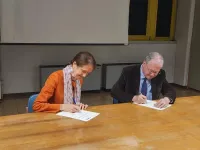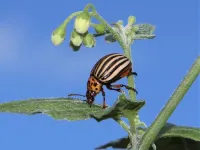(Press-News.org) FAPESP representatives visited the headquarters of Italy’s Consiglio Nazionale delle Ricerche (CNR) in Bologna on October 16th to sign a new work plan that will enable the implementation of a cooperation agreement signed by the institutions in December 2023.
The aim is to enable joint funding of research projects in the following areas: Cultures, Inmaterial Heritage, Interdisciplinary Networks; Agri-food and Sustainable Development; Technology and Innovation; and Health and the Environment.
Researcher mobility and other mutually agreed cooperative initiatives may also be funded.
The document, which was signed by Virginia Coda, head of International Relations at the CNR, and Marco Antonio Zago, president of FAPESP, establishes that a joint call for proposals will be announced every two years, with the first one scheduled for April 2025. Two-year projects will be supported.
“We believe that, as always, many researchers will submit projects because the link between Brazil and Italy is extremely strong. We’re really happy, we feel a strong connection with Brazil. All Italians,” said Coda.
“It’s a pleasure to be here again. FAPESP’s first agreement with the CNR was signed in 2012, when I was Dean of Research at the University of São Paulo. And we’ve renewed this partnership many times. This provides a special opportunity for collaboration between Italy and the state of São Paulo,” noted Zago.
END
FAPESP and CNR plan to launch joint call for proposals in April 2025
The work plan for the next five years was signed by representatives of the two agencies on October 16th in Bologna.
2024-10-17
ELSE PRESS RELEASES FROM THIS DATE:
Smaller, more specific academic journals have more sway over policy
2024-10-17
DURHAM, N.C. – Scientists don't just want their results to be published; they want them to be published in the most influential journal they can find. This focus on a high 'impact factor' is driven by their concerns about promotion and tenure, but it may be overlooking the important role that smaller publications can play in the advancement of their science.
A new paper, “Role of low-impact-factor journals in conservation implementation,” appearing Oct. 17 in the journal Conservation ...
Medicaid ACOs have not yet improved care for kids with asthma
2024-10-17
In its first three years of operation, Medicaid’s primary care-focused Accountable Care Organizations (ACOs) in Massachusetts showed “no clear evidence of success” in improving asthma care for children, according to research led by the University of Massachusetts Amherst and UMass Chan Medical School-Baystate Health.
The study, published recently in JAMA Pediatrics, compared the asthma care of Medicaid-insured children affiliated with a Medicaid ACO to that of children with private insurance. Senior author Dr. Sarah Goff, a practicing pediatrician and internist ...
New study sheds light on lily toxicity in cats; outpatient treatment may be viable option
2024-10-17
FOR MORE INFORMATION
Michael San Filippo
Senior Media Relations Manager
American Veterinary Medical Association
Cell/Text: 847-732-6194
msanfilippo@avma.org
New study sheds light on lily toxicity in cats; outpatient treatment may be viable option
(SCHAUMBURG, Illinois) October 17, 2024—A study published recently in the Journal of the American Veterinary Medical Association (JAVMA) has revealed new insights into the treatment of cats exposed to toxic lilies, offering hope for pet owners facing this common household hazard.
The study (“Prevalence of acute kidney ...
A new benchmark to recognize the hardest problems in materials science
2024-10-17
Scientists hope that quantum computing will help them study complex phenomena that have so far proven challenging for current computers – including the properties of new and exotic materials. But despite the hype surrounding each new claim of “quantum supremacy”, there is no easy way to say when quantum computers and quantum algorithms have a clear and practical advantage over classical ones.
A large collaboration led by Giuseppe Carleo, a physicist at the Swiss Federal Institute for Technology (EPFL) in Lausane and the member of the National Center for Competence in Research NCCR MARVEL, has now ...
Why do we love carbs? The origins predate agriculture and maybe even our split from Neanderthals
2024-10-17
If you’ve ever struggled to reduce your carb intake, ancient DNA might be to blame.
It has long been known that humans carry multiple copies of a gene that allows us to begin breaking down complex carbohydrate starch in the mouth, providing the first step in metabolizing starchy foods like bread and pasta. However, it has been notoriously difficult for researchers to determine how and when the number of these genes expanded. Now a new study led by The University of Buffalo (UB) and The Jackson Laboratory (JAX) showcases how early duplications of this ...
Key protein for the biosynthesis of defense steroids in solanaceous plants discovered
2024-10-17
The biosynthetic pathway of specific steroidal compounds in nightshade plants (such as potatoes, tomatoes and eggplants) starts with cholesterol. Several studies have investigated the enzymes involved in the formation of steroidal glycoalkaloids. Although the genes responsible for producing the scaffolds of steroidal specialized metabolites are known, successfully reconstituting of these compounds in other plants has not yet been achieved. The project group ‘Specialized Steroid Metabolism in Plants’ in the Department of Natural Product Biosynthesis, led by Prashant Sonawane, who is now Assistant ...
Global CO2 emissions from forest fires increase by 60%
2024-10-17
A major new study reveals that carbon dioxide (CO2) emissions from forest fires have surged by 60% globally since 2001, and almost tripled in some of the most climate-sensitive northern boreal forests.
The study, led by the University of East Anglia (UEA) and published today in Science, grouped areas of the world into ‘pyromes’ - regions where forest fire patterns are affected by similar environmental, human, and climatic controls - revealing the key factors driving recent increases in forest fire activity.
It is one of the first studies to look globally at the differences between forest ...
AI-assisted deliberation can help people with different views find common ground
2024-10-17
A new study shows that an artificial intelligence (AI) tool can help people with different views find common ground by more effectively summarizing the collective opinion of the group than humans. By producing statements that convey the majority opinion, while incorporating the minority’s perspective, the AI produced outputs that participants preferred—and that they rated as more informative, clear, and unbiased, compared to those written by human mediators. Human society is enriched by a plurality of viewpoints, but agreement is a prerequisite for people to act collectively. ...
Special Issue explores factors influencing democratic attitudes, and what’s at stake for science in the U.S. after November election
2024-10-17
The health of American democracy is facing challenges, with experts pointing to recent democratic backsliding, deepening partisan divisions, and growing anti-democratic attitudes and rhetoric. In this issue of Science, Research Articles, a Policy Forum, a Science News feature, and a related Editorial highlight how the tools of science and technology are being used to address this growing concern and how the upcoming U.S. presidential election could impact U.S. science.
In one research study in this special issue, Jonathan Chu and colleagues sought to understand whether understandings ...
Extratropical forest fire emissions are increasing as climate changes
2024-10-17
As climate change promotes fire-favorable weather, climate-driven wildfires in extratropical forests have overtaken tropical forests as the leading source of global fire emissions, researchers report. The findings raise urgent concerns about the future of forest carbon sinks under climate change. Fire has long played a role in shaping Earth's forests and regulating carbon storage in ecosystems. However, anthropogenic climate change has intensified fire-prone weather, leading to an increase in burned areas and carbon emissions, particularly in forested regions. These fires not only reduce forests' ability to absorb carbon but also disrupt ecosystems, harm biodiversity, and pose significant ...
LAST 30 PRESS RELEASES:
Common brain parasite can infect your immune cells. Here's why that's probably OK
International experts connect infections and aging through cellular senescence
An AI–DFT integrated framework accelerates materials discovery and design
Twist to reshape, shift to transform: Bilayer structure enables multifunctional imaging
CUNY Graduate Center and its academic partners awarded more than $1M by Google.org to advance statewide AI education through the Empire AI consortium
Mount Sinai Health system receives $8.5 million NIH grant renewal to advance research on long-term outcomes in children with congenital heart disease
Researchers develop treatment for advanced prostate cancer that could eliminate severe side effects
Keck Medicine of USC names Christian Pass chief financial officer
Inflatable fabric robotic arm picks apples
MD Anderson and SOPHiA GENETICS announce strategic collaboration to accelerate AI-driven precision oncology
Oil residues can travel over 5,000 miles on ocean debris, study finds
Korea University researchers discover that cholesterol-lowering drug can overcome chemotherapy resistance in triple-negative breast cancer
Ushikuvirus: A newly discovered giant virus may offer clues to the origin of life
Boosting the cell’s own cleanup
Movement matters: Light activity led to better survival in diabetes, heart, kidney disease
Method developed to identify best treatment combinations for glioblastoma based on unique cellular targets
Self-guided behavioral app helps children with epilepsy sleep earlier
Higher consumption of food preservatives is associated with an increased risk of type 2 diabetes
NTU Singapore-led team captures first-ever ‘twitch’ of the eye’s night-vision cells as they detect light, paving the way for earlier detection of blindness-causing diseases
Global aviation emissions could be halved through maximising efficiency gains, new study shows
Fewer layovers, better-connected airports, more firm growth
Exposure to natural light improves metabolic health
As we age, immune cells protect the spinal cord
New expert guidance urges caution before surgery for patients with treatment-resistant constipation
Solar hydrogen can now be produced efficiently without the scarce metal platinum
Sleeping in on weekends may help boost teens’ mental health
Study: Teens use cellphones for an hour a day at school
After more than two years of war, Palestinian children are hungry, denied education and “like the living dead”
The untold story of life with Prader-Willi syndrome - according to the siblings who live it
How the parasite that ‘gave up sex’ found more hosts – and why its victory won’t last
[Press-News.org] FAPESP and CNR plan to launch joint call for proposals in April 2025The work plan for the next five years was signed by representatives of the two agencies on October 16th in Bologna.



